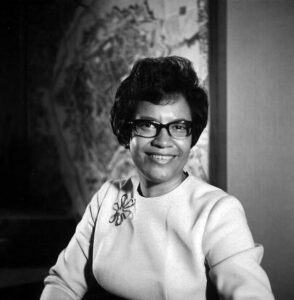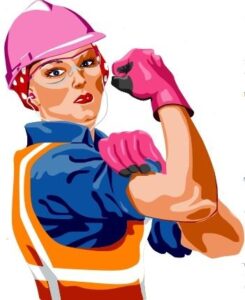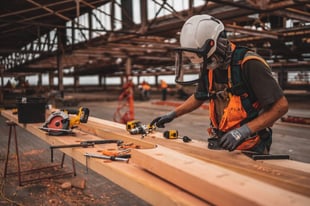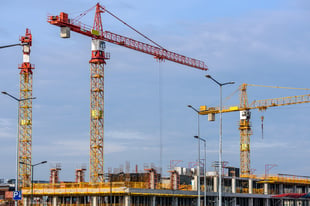The Growing Role of Women in Construction
Women have been working in construction, since, well, probably forever; however, like all marginalized groups, their contributions have been pretty much written out of history—or was never written in in the first place.
For women in construction, especially in our ancient history, it was seen as immoral for a woman to work outside the home and earn wages, so records weren’t kept. There are records of women working as day laborers on wood and stone structures in Navarre, Spain in the 13th century, but not much else is known. It is commonly thought that these early women construction workers were single with no family and sometimes even slaves. Either way, these records weren’t in celebration or recognition of the women’s work. It wasn’t until the 1800s that women in the AEC industry were formally recognized as making significant contributions to construction.
When researching women in construction history, you will find disruptors, scholars, trailblazers, and many ‘firsts. Most of these women came from privileged backgrounds who shadowed fathers or husbands and were predominately architects and designers. In the 1800s, there was Julia Morgan, the first woman to graduate from UC Berkeley with a civil engineering degree, Louise Blanchard Bethune, the first woman admitted to an architectural professional association, Emily Roebling who served as Chief Engineer on the Brooklyn Bridge, and Marion Mahony Griffin, one of the earliest licensed women architects and Frank Lloyd Wright’s first employee.
 Photo of Norma Merrick Sklarek courtesy of Pioneering Women
Photo of Norma Merrick Sklarek courtesy of Pioneering WomenThrough the early and mid-1900s, more opportunities for women and women of color to study emerged. As a result, more women entered the construction industry including Ethel Furman, Beverly Loraine Greene, Georgia Louise Harris Brown, and Noma Merrick Sklarek, some of the earliest black women to be licensed architects in the U.S.
Out of necessity, during WWI and WWII, more women than ever worked in the construction and manufacturing industries. Women operated heavy machinery, were riveters, welders, and electrical engineers. However, when soldiers returned home, women left the paid labor force and returned home to domestic work.
Labor laws in the 1960s and 70s made it easier for women to join the workforce. From 1960 to 1980, the number of women working outside the home increased 27%, and then, in 1980, 70% of women were working outside the home. During the 1980s, those women who worked in construction, 68% held desk or supportive jobs.
Before the recession, women in construction jobs peaked at 1,131,000 in 2006. In 2010, there were only 800,000 women employed in the industry, 200,000 of those were physical laborers. Women reentered the field in 2013 and 2015, the number of women working in construction grew to 1,102,000. Today, women make up 10% of the construction workforce with most of that 10 percent (still) working desk jobs or in supportive roles. Only 1 in 100 women in the construction industry work in the field. (Let's Celebrate the Women in Construction | For Construction Pros)
Though there is still a stigma attached to women working in the construction industry and many challenges for those who do enter the field, the growing roles they play in AEC have reached historical numbers. From 2014 to 2019, the construction industry saw the second-highest increase in women-owned businesses. According to NSSI, “13% of construction firms are women-owned” and “Forty-four out of the top 100 construction firms have women in construction management.” (2019). This is a 94% increase in women own construction firms since 2007. (Women in Construction: The Future Is Female – National Surety Services)
It has been challenging at times to be a female leader in a traditionally male-dominated industry. My hope is that my visibility as a female construction leader will attract other women to the industry. -Kim Roy
Women in C-Suite-level positions have also increased. Two of Beck Technology’s clients boast female C-Suite leadership: CEO Kim Roy at HITT Construction and U.S. Civils Department Vice President & General Counsel Christine M. McAnney at Balfour Beatty. Also, in 2019, The Family Handyman writes, that “the share of women working in construction hit a 20-year high.” (History of Women in Construction | The Family Handyman)
In 2021, SmartAsset, an online financial advisor says three of the top fastest-growing jobs for women are in construction with a 101% increase in women construction managers. (Fastest-Growing Jobs for Women in America)
 We can do it!
We can do it!There are many reasons why we should support initiatives to recruit women to the construction industry. Here are four of our favorites:
- The gender wage gap is the lowest in construction than any other industry. Women earn 94 cents to every dollar a man makes. The average is 81 cents.
- Construction companies with women in leadership roles report higher profits than those that don’t. (Women in Construction: The State of the Industry in 2022 | BigRentz)
- Women are happy in construction! Levelset surveyed 1,001 women in the construction industry in February 2021 and 78% reported loving their jobs. Women in Construction: 2021 Survey Results (levelset.com)
- There are plenty of jobs to be had! The construction industry is facing a severe labor shortage, especially in skilled laborers. The U.S. Bureau of Labor Statistics estimates that the need for construction manager jobs will increase 10% by 2028.
For women in the industry or those who are interested in pursuing a career in construction, there are many resources available for support, networking, and professional development like Professional Women in Construction, Women Construction Owners and Executives (WCOE), Lowe’s digital movement Generation T, Beck Technology partner Miron Construction’s Build Like a Girl, and the National Association of Women in Construction (NAWIC), which founded Women in Construction Week.
Founded in 1953 in Fort Worth, Texas to support women working in construction, NAWIC now has 114 chapters throughout the country. The organization started Women in Construction Week (WIC Week) in 1998 to celebrate, educate, and promote the role of women in the industry. 2022’s “theme is ‘Envision Equity’, which seeks to raise awareness of opportunities for women to enjoy a wide range of roles in the construction industry, from tradeswomen to project managers to administrative positions and even businesses ownership.” This year’s WIC Week is recognized March 6-12. For more on WIC Week events open to anyone.

-1.png?width=112&height=112&name=image%20(4)-1.png)














